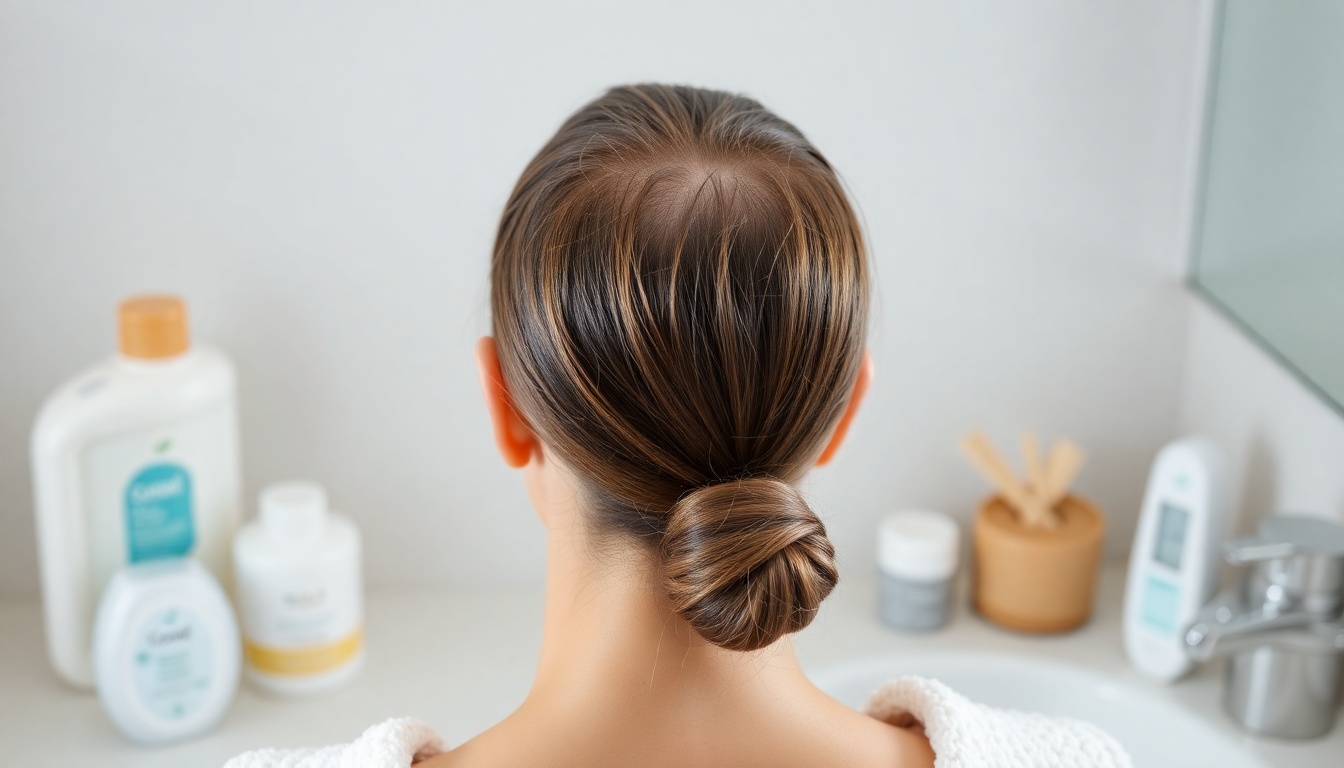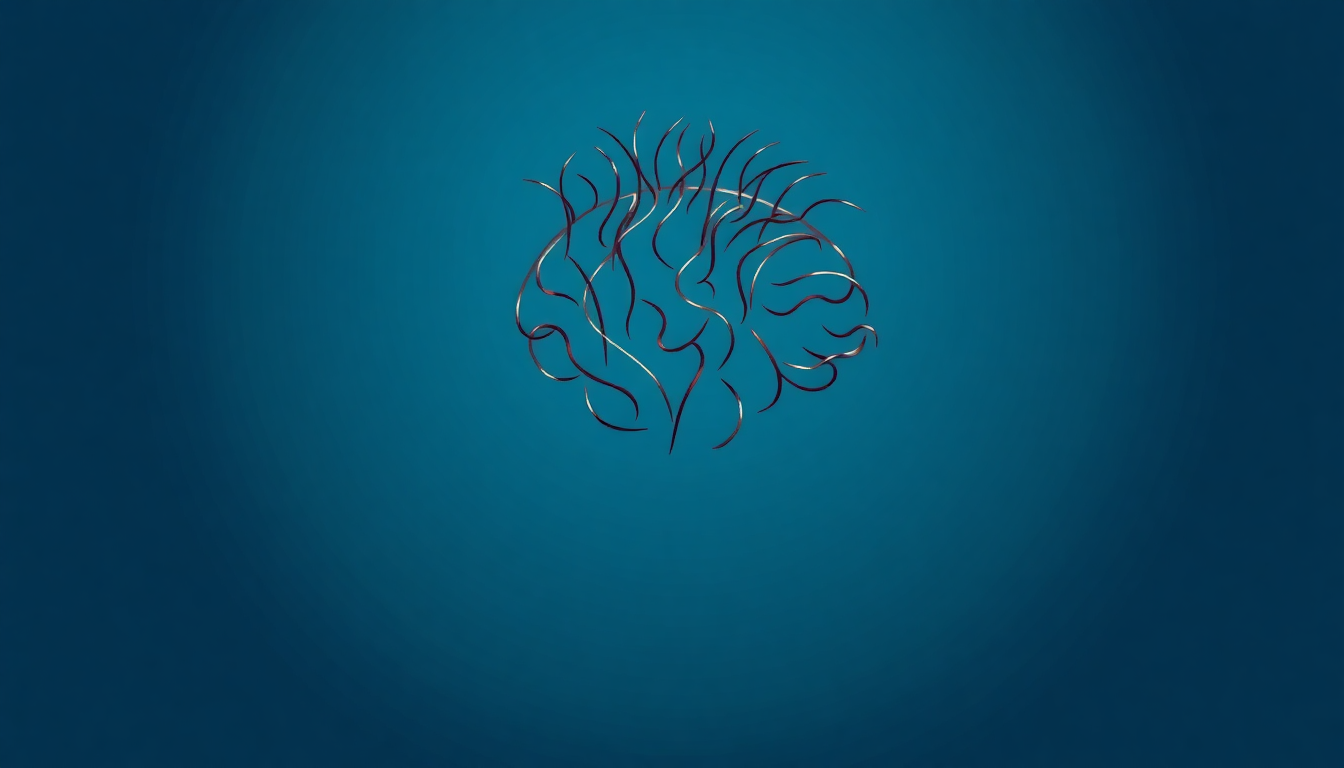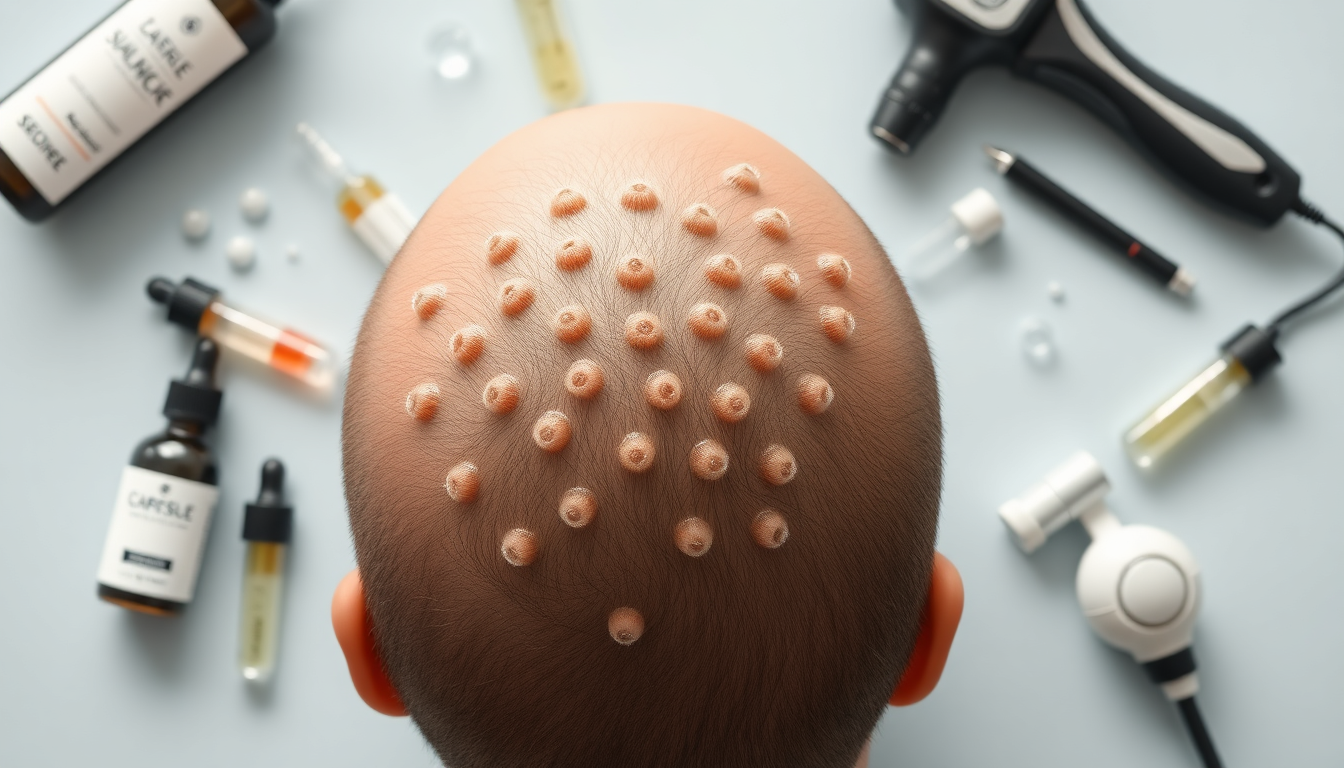Introduction
Scalp stacking is the strategic, evidence-minded layering of products and devices that target complementary mechanisms to help hair look and become denser over time. Instead of random product shopping, a properly staged routine—based on a careful scalp diagnosis—lets peptides, prebiotics and at-home devices amplify one another while minimizing irritation. This comprehensive guide walks you through diagnosis, ingredient selection, device protocols, a practical schedule, troubleshooting and professional red flags. Follow the checklist, track progress, and youll have a reproducible plan for denser-looking hair.
What Is Scalp Stacking and Why It Works
Scalp stacking combines three evidence-informed pillars:
- Topical biochemical stimulation (peptide serums) to support follicle activity and hair shaft thickness.
- Microbiome-supportive treatments (prebiotics) that reduce inflammation and balance sebum decomposition.
- Mechanical and light-based at-home devices (microneedling, low-level laser/red light, massagers) to enhance circulation, collagen production and topical delivery.
When chosen and timed correctly, these elements act synergistically: prebiotics calm and condition the scalp for better tolerance, peptide serums deliver targeted growth signals, and devices increase blood flow and topical absorption.
Step 1 — Diagnose Your Scalp: A Detailed Checklist
Accurate diagnosis is the foundation of any stacking plan. Use the checklist below to classify your scalp and identify the predominant issue(s).
- Sebum & oiliness: Check 2–3 hours and 24 hours after a gentle cleanse. Is the scalp shiny, slick, or quickly greasy?
- Dryness & barrier status: Visible flakes, tightness, or a tendency to flake after brushing indicate a dry or compromised barrier.
- Sensitivity & inflammation: Itching, burning, visible redness or soreness are signs of inflammation—treat gently and consult a professional if severe.
- Shedding pattern: Is shedding diffuse across the crown, concentrated at the temples, or patchy? Diffuse suggests chronic shedding or androgenetic thinning; patchy can indicate alopecia areata or other conditions—seek a dermatologist for sudden patchy loss.
- Build-up & product residue: Heavy conditioners, dry shampoos or styling products may create occlusive layers that reduce serum penetration.
- Odor: Persistent scalp odor suggests microbiome imbalance and is often helped by prebiotic approaches.
- Medical history: Recent systemic illness, thyroid issues, medications, pregnancy/postpartum, nutritional deficits and stress can drive hair shedding. Address systemic causes with a clinician.
Keep a quick log for 2–4 weeks to confirm patterns before committing to intensive stacking.
Common Scalp Diagnoses and How They Change Your Stack
- Oily, inflamed scalp: Emphasize clarifying cleanses, lightweight peptide serums, and prebiotics that modulate sebum breakdown. Avoid heavy oils.
- Dry, flaky scalp: Support barrier repair with humectants (niacinamide, panthenol) and low-irritant peptide serums. Limit clarifying shampoos.
- Seborrheic dermatitis: Treat inflammation first (control flares with medicated shampoos or prescriber advice), then introduce prebiotics and peptides slowly.
- Diffuse thinning / androgenetic tendencies: Use peptides known to support anagen maintenance, consistent LLLT use, and consider medical evaluation for oral/topical prescription options.
- Telogen effluvium (post-stressor shedding): Focus on soothing prebiotics, barrier repair and gentle stimulation; expect gradual recovery over months.
Step 2 — Peptide Serums: Types, Mechanisms & How to Choose
Peptides are short amino acid chains that can act as signaling molecules. For scalp and hair, look for peptides that support extracellular matrix repair, microcirculation, and follicle signaling. Important peptide groups and supportive actives:
- Copper peptides (GHK-Cu): Known for wound healing and matrix support, they may improve follicle environment and hair shaft quality.
- Biomimetic peptides (e.g., Acetyl tetrapeptide-3): Designed to mimic growth factors and reduce miniaturization signals.
- Signal peptides: Peptides that modulate collagen, keratinocyte activity and microvascular responses.
- Supporting ingredients: Niacinamide for circulation and barrier benefits, panthenol (pro-vitamin B5) for hydration, glycerin and light humectants for scalp comfort.
How to choose:
- Prioritize named peptides and transparent formulations over vague proprietary blends.
- Prefer water- or lightweight serum vehicles for scalp penetration.
- Look for clinical evidence or published formulation rationale; reputable brands provide ingredient lists and usage guidance.
Shop smart example: search for a "peptide serum for hair" with clear peptide names and topical concentration guidance at the product page. For convenience, curated routines are available—such as a complete peptide-based scalp care line at Eelhoe Cosmetics.
Step 3 — Prebiotic Scalp Treatments: Science & Selection
Prebiotics are substrates that support beneficial microbes. On the scalp, they help reduce dysbiosis-driven inflammation and undesirable metabolite production (which can create odor and irritation). Prebiotics differ from probiotics (live microbes) and postbiotics (microbial metabolites); for scalp use, prebiotics are often easier to formulate and store.
- Common prebiotic ingredients: Inulin, fructooligosaccharides (FOS), plant-derived oligosaccharides, and select polyphenols that preferentially support commensal microbes.
- Benefits: Reduced odor, calmer scalp, better barrier support and reduced flaking from microbiome imbalance.
- Formulation notes: Many prebiotic scalp treatments come as leave-ons or masks to be used 1–3 times weekly; they should be compatible with subsequent serums if allowed to absorb.
Pairing tip: Apply prebiotics after cleansing and allow 10–30 minutes for absorption before applying peptide serums or using devices that might increase penetration.
Example shopping anchor: find a targeted "prebiotic scalp treatment" and complementary products at Eelhoe Cosmetics to integrate into your weekly routine.
Step 4 — At-Home Devices: What Works & Safety Guidelines
Devices can boost circulation, stimulate growth-related pathways and enhance topical delivery. Use them as adjuncts—not replacements—for well-formulated actives. Below are common device categories with practical guidance.
-
Microneedling (dermarollers, pens):
- Recommended home needle lengths: 0.25mm for topical absorption, 0.5mm to 1.0mm for collagen stimulation and improved microcirculation. 1.5mm and above should only be used by professionals.
- Frequency: 0.25mm can be used weekly; 0.5mm every 10–14 days; 1.0mm every 3–4 weeks. Always follow device instructions and sanitation procedures.
- Safety: Clean devices with alcohol between uses, avoid on active infection or inflamed scalp, and patch-test serums to avoid post-needling irritation. If you experience significant bleeding, severe pain, or prolonged redness, stop and consult a clinician.
-
Low-Level Laser Therapy (LLLT) / Red Light:
- Typical therapeutic red wavelengths used in consumer devices are in the 630–680nm range (red) and sometimes 800–880nm (near-infrared). These wavelengths can increase mitochondrial activity and reduce inflammation when used regularly.
- Frequency: Many devices are designed for daily or thrice-weekly use; typical sessions are 10–20 minutes.
- Safety: Red light is non-ablative and generally safe; avoid directing intense LEDs into the eyes and follow manufacturer guidance.
-
Scalp massagers & sonic applicators:
- These increase blood flow, manually reduce tension and help distribute products across the scalp.
- Gentle daily use is generally safe and well-tolerated.
Stacking Order: Optimal Timing and Pairing Rules
Follow layering rules to maximize benefits and minimize irritation:
- Always start with a clean scalp—clarifying when needed to remove residue and oils that impede absorption.
- Apply prebiotic treatments on their scheduled days (usually 1–3×/week). Let them absorb fully before adding other actives.
- Apply peptide serums to a dry or slightly damp scalp. Massage gently for 60–90 seconds to improve distribution.
- For red light therapy, use it after peptide application or as recommended by your device. Red light can complement the serums effects by improving microcirculation.
- If you use microneedling at home with needles 0.5mm or longer, avoid applying strong actives immediately afterward. Wait 24–48 hours for deeper needling, or choose milder, sterile serums for immediate post-needling application.
- Introduce one new element (a new peptide, prebiotic, or device) every 2–4weeks so you can spot irritation or benefits.
Sample 16-Week Progressive Protocol (Checklist)
Below is a practical, progressive plan you can adapt to your diagnosis.
- Weeks 1–4: Baseline
- Cleanse with a gentle clarifying or balanced shampoo 1–3×/week as needed.
- Start a gentle, water-based peptide serum nightly. Patch-test first.
- Use a scalp massager 2×/week to improve circulation during serum application.
- Track photos and symptoms weekly.
- Weeks 5–8: Add prebiotics and LLLT
- Add a prebiotic scalp treatment 1–2×/week after cleansing; allow to absorb before the peptide serum.
- Introduce red light therapy 3×/week for 10–15 minutes after peptide application.
- Weeks 9–16: Introduce targeted device and adjust frequency
- Consider home microneedling at 0.5mm every 10–14 days (only if comfortable and no contraindications). Skip peptides for 24–48 hours after deeper sessions.
- Continue peptides nightly, prebiotics weekly, and red light 3×/week.
- Reassess photos at weeks 8 and 16 and adjust frequency if irritation arises.
How to Read Labels & Build a Shopping Checklist
When shopping, use this checklist to compare products:
- Ingredient transparency: Are peptides named (e.g., GHK-Cu, Acetyl tetrapeptide-3)?
- Vehicle & texture: Water-based serums for scalps; avoid heavy occlusive oils if youre prone to buildup.
- Prebiotic specificity: Look for inulin, FOS or plant oligosaccharides listed on the label.
- Clinical info: Product pages that include application guidance, clinical summaries or references indicate better formulation rigor.
- Packaging & preservative systems: Airless pumps help maintain peptide stability.
Example: add a reputable "peptide serum for hair" and a complementary "prebiotic scalp treatment" to your cart from a curated line like Eelhoe Cosmetics, which offers combined routines and clear ingredient lists.
Patch Testing & Safety First
- Always patch test new serums on an inconspicuous area (behind the ear or inner forearm) for 48–72 hours.
- Stop use and consult a clinician if you develop intense itching, swelling, blistering, or persistent redness.
- Avoid combining aggressive chemical exfoliants and mechanical devices on the same day to limit barrier disruption.
- If you have autoimmune hair loss, open wounds, scalp psoriasis, or active infection, consult a dermatologist before starting microneedling or introducing potent topicals.
Tracking Progress: Metrics That Matter
Objective tracking helps you know whats working:
- Standardized photos: Use the same camera, lighting and parting every 4 weeks.
- Shedding count: Use a simple method—run fingers through hair over a clean towel and estimate shedding once weekly.
- Scalp comfort log: Note oiliness, itching, flaking and odor changes after each treatment week.
- Product/device log: Record dates and any immediate reactions so you can correlate changes with new elements.
Troubleshooting & Common Questions
- Im irritated—what do I do? Stop the newest product or device, return to a simple routine (gentle cleanser, barrier-soothing humectants like panthenol), and reintroduce items one at a time after symptoms resolve. If irritation persists, see a dermatologist.
- No visible results after 12 weeks—should I keep going? Hair cycles are slow; many users need 16–24weeks of consistent use to notice density changes. Re-evaluate adherence, diagnosis, and consider professional evaluation if no improvement after 6 months.
- Can I combine prescription topicals (like minoxidil) with stacking? Many users do, but follow your prescribers guidance. If combining, stagger applications and watch for increased irritation.
When to See a Dermatologist or Trichologist
Seek professional care if you have:
- Sudden, rapid or patchy hair loss.
- Severe scalp pain, sores, pus, significant bleeding or signs of infection.
- Persistent, widespread inflammation or flaking that doesnt respond to OTC measures.
- Underlying medical conditions (thyroid disease, autoimmune disorders) that could cause hair loss.
Realistic Expectations & Timeline
- 0–4 weeks: Improved scalp comfort and reduced flaking for many users, especially after adding prebiotics.
- 8–12 weeks: Early signs of reduced shedding and thicker appearance of fine hairs for some users.
- 16–24 weeks: Noticeable changes in hair density with consistent use and correct diagnosis; maintain routine for long-term benefits.
Case Study Examples (Illustrative)
These are illustrative scenarios to show how diagnosis shapes a stack.
- Case A - Oily, diffuse thinning: Clarifying shampoo 1×/week, light peptide serum nightly, prebiotic scalp wash 2×/week, red light 3×/week, massager daily. Outcome: reduced oil, less shedding at week 12, thicker fine hairs by week 20.
- Case B - Dry, thinning crown and sensitivity: Gentle sulfate-free cleansing, barrier-supporting peptide serum with panthenol nightly, prebiotic hydrator once weekly, avoid deep microneedling, use low-frequency red light. Outcome: less sensitivity, visible miniaturized hair improvement after 16–24weeks.
Final Checklist: Your Scalp Stacking Launch Plan
- Step 1: Diagnose your scalp for oiliness, sensitivity, shedding pattern and build-up.
- Step 2: Select a transparent peptide serum (look for named peptides and water-based delivery).
- Step 3: Add a prebiotic scalp treatment 1–3×/week depending on need.
- Step 4: Introduce one device at a time—start with gentle massagers or red light before microneedling.
- Step 5: Track photos, shedding and scalp comfort weekly; re-evaluate every 8–12weeks.
For a curated, ready-to-use routine that pairs peptides, prebiotics and supportive device guidance, consider reviewing complete regimens such as those offered by dedicated scalp care brands. Explore a selection of peptide serums and prebiotic scalp treatments designed to work together at Eelhoe Cosmetics.
Conclusion — Start Smart, Track Consistently, and Optimize
Scalp stacking can be a high-yield approach when its built on careful diagnosis, thoughtful ingredient selection, conservative device use and consistent tracking. Dont rush: introduce one variable at a time, prioritize scalp comfort and be patient—hair biology takes time to change. If youre ready to get organized, use the checklists above and consider a curated combination of peptide serum and prebiotic scalp treatments from a single line to simplify compatibility.
If youre interested in tried-and-curated product pairings, visit Eelhoe Cosmetics to explore peptide serums, prebiotic scalp treatments and complete scalp care routines. Ready to build a denser-looking hair routine? Shop Eelhoe hair growth products and start your scalp stacking journey with formulations designed to work together.
Frequently Asked Questions
- Q: Can I use oil-based serums with peptides? A: Avoid heavy oils that occlude follicles; lightweight or water-based peptide serums are preferable for scalp application.
- Q: Will red light interfere with topical ingredients? A: Red light generally complements topicals by improving circulation and is safe to use with serums; follow device guidance.
- Q: Is prebiotic scalp care safe for sensitive scalps? A: Many prebiotics are gentle, but patch-test first and choose formulations labeled for sensitive scalps if youre reactive.
- Q: How long before I should stop if nothing changes? A: Reassess after 16–24weeks; if no improvement and you maintained adherence, consult a dermatologist for additional evaluation.
Good luck with your scalp stacking. With patience, a clear plan and consistent tracking, you can maximize the odds of noticeable improvement in hair density.




Leave a comment
All comments are moderated before being published.
This site is protected by hCaptcha and the hCaptcha Privacy Policy and Terms of Service apply.